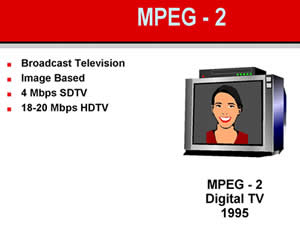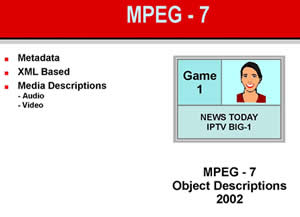Difference between MPEG2 and MPEG7
Key difference: MPEG stands for the Moving Picture Experts Group. MPEG2 was released in 1995 and is effectively the successor to MPEG1. It is quite similar MPEG1, and aimed to improve on the previous format. MPEG2 includes generic coding of moving pictures and associated audio information. MPEG7 was released in 2002 and is a Multimedia content description standard. It is different that the previous formats, as unlike MPEG-1, MPEG-2 and MPEG-4, it does not deal with coding of moving pictures and audio. In fact, MPEG7 allows the embedding of metadata information into audio and video files.
 MPEG stands for the Moving Picture Experts Group. It is a working group of experts that was formed in 1988 by ISO and IEC. It was a joint initiative between Hiroshi Yasuda of the Nippon Telegraph and Telephone and Leonardo Chiariglione. Chiariglione has served as the group’s Chair since the group’s inception.
MPEG stands for the Moving Picture Experts Group. It is a working group of experts that was formed in 1988 by ISO and IEC. It was a joint initiative between Hiroshi Yasuda of the Nippon Telegraph and Telephone and Leonardo Chiariglione. Chiariglione has served as the group’s Chair since the group’s inception.
The aim of MPEG was to set standards for audio and video compression and transmission. By 2005, the group has grown to include approximately 350 members per meeting from various industries, universities, and research institutions.
The standards as set by MPEG consist of different Parts. Each part covers a certain aspect of the whole specification. MPEG has standardized the following compression formats and ancillary standards:
- MPEG-1 (1993): Coding of moving pictures and associated audio for digital storage media at up to about 1.5 Mbit/s (ISO/IEC 11172). Designed to compress VHS-quality raw digital video and CD audio without excessive quality loss, making video CDs, digital cable/satellite TV and digital audio broadcasting (DAB) possible. It includes the popular MPEG1 Audio Layer III (MP3) audio compression format.
- MPEG-2 (1995): Generic coding of moving pictures and associated audio information (ISO/IEC 13818). Describes a combination of lossy video compression and lossy audio data compression methods, which permit storage and transmission of movies using currently available storage media and transmission bandwidth.
- MPEG-3: Dealt with standardizing scalable and multi-resolution compression and was intended for HDTV compression but was found to be redundant and was merged with MPEG2.
- MPEG-4 (1999): Coding of audio-visual objects. Includes compression of AV data for web (streaming media) and CD distribution, voice (telephone, videophone) and broadcast television applications. It includes the MPEG-4 Part 14 (MP4).
- MPEG-7 (2002): Multimedia content description interface. Not a standard which deals with the actual encoding of moving pictures and audio, like MPEG1, MPEG2 and MPEG4. It uses XML to store metadata, and can be attached to timecode in order to tag particular events, or synchronize lyrics to a song.
- MPEG-21 (2001): Multimedia framework. It is aimed at defining an open framework for multimedia applications. Based on definition of a Digital Item and users interacting with Digital Items.
MPEG2 was released in 1995 and is effectively the successor to MPEG1. It is quite similar MPEG1, and aimed to improve on the previous format. MPEG2 includes generic coding of moving pictures and associated audio information. It improves the compression factor and enhances the capabilities of MPEG1, so that MPEG2 is mainly used for DVD videos, as well as broadcasting digital television including terrestrial, cable and satellite.
MPEG2 is also a lossy compression, however, MPEG2 allows for better resolution. It also used higher bit-rates. A lossy compression means that while saving a file, there is a slight loss of quality due to compression. With each re-save there a slight loss of quality due to compression. Hence, it is not the greatest format in case one needs to keep making numerous edits and re-saves to the image. Still, if one only makes a few edits and the file is saved in a high quality format, the slight loss of quality due to compression is mainly negligible. An advantage to using this format is that due to compression, the file will take up less space for data storage.
Furthermore, MPEG2 addressed some weaknesses of the MPEG1, which included:
- Audio compression limited to two channels
- No standardized support for interlaced video with poor compression when used for interlaced video
- Limited standardized profile which was incompatible for video with higher resolutions. Support for 4k video but no practical way to encode video for higher resolutions
- Limited identification of supporting hardware
- Only one color space support – 4:2:0
Additionally, MPEG2 also incorporated support for Variable quantization and VBR. MPEG2 also has a more complex encoding algorithm, due to which it is in incompatible with MPEG1. Hence, MPEG1 players are not able to decode and play MPEG2 files.
 MPEG7 was released in 2002 and is a Multimedia content description standard. It is different that the previous formats, as unlike MPEG-1, MPEG-2 and MPEG-4, it does not deal with coding of moving pictures and audio. In fact, MPEG7 was designed to standardize: a set of description schemes and descriptors; a language to specify these schemes, called the Description Definition Language (DDL); and a scheme for coding the description.
MPEG7 was released in 2002 and is a Multimedia content description standard. It is different that the previous formats, as unlike MPEG-1, MPEG-2 and MPEG-4, it does not deal with coding of moving pictures and audio. In fact, MPEG7 was designed to standardize: a set of description schemes and descriptors; a language to specify these schemes, called the Description Definition Language (DDL); and a scheme for coding the description.
MPEG7 allows the embedding of metadata information into audio and video files. Hence, the audio and video files can be searched and indexed based on the information about the content instead of searching the actual content bitstream. MPEG7 does this by using XML to store the metadata. It can then be attached to timecode in order to tag particular events, or synchronize lyrics to a song. An advantage to using XML to store the metadata is that XML is universal. Hence, MPEG7 can be read my most existing tools that support XML parsing.
MPEG7 is not generally used today by the average user and adoption has been slow. However, Wikipedia lists the many applications and application domains that can benefit from the format, including:
- Digital library: Image/video catalogue, musical dictionary.
- Multimedia directory services: e.g. yellow pages.
- Broadcast media selection: Radio channel, TV channel.
- Multimedia editing: Personalized electronic news service, media authoring.
- Security services: Traffic control, production chains, etc.
- E-business: Searching process of products.
- Cultural services: Art-galleries, museums, etc.
- Educational applications.
- Biomedical applications.
Image Courtesy: althos.com









Comments
Cool text dude, keep up the good work, just shared this with the mates
Nike
Fri, 01/30/2015 - 16:08
Add new comment